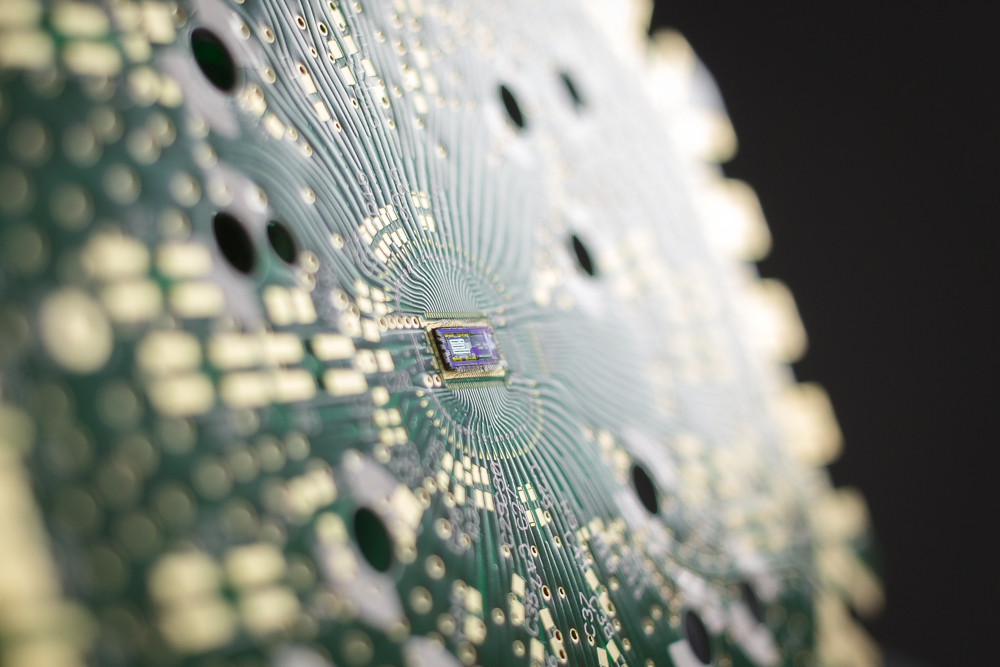Optoelectronic transmission & reception system integrated on silicon chip. (Copyright: AIT / Michael Mürling)
The benefits of harnessing light have been evidenced in numerous technological breakthroughs during the early 21st century, including global connectivity at an unprecedented speed, industrial manufacturing of extraordinary quality, and very sensitive and highly specific tools for sensing the environment. The AIT Austrian Institute of Technology is now pushing the limits of sensor technology through its innovative trans-national research project “LIANDRI – Advancing time-of-flight technology for high performance light detection and ranging”. The goal is to bridge innovative yet application-driven research on photonic sensing with near-future exploitation in the fields of automated driving and industrial manufacturing. In the medium term, LIANDRI’s findings will enable cars to recognize and identify distant yet small obstacles along road infrastructure, while robots in future factories will be able to more efficiently perform manufacturing tasks that require precise alignment and tooling procedures.
Vienna, 08 August 2018 (AIT): Sensor technology is enriching our everyday lives and plays a vital role in a wide range of applications – spanning from daily appliances such as those used for temperature regulation to more sophisticated industrial environments where they are key in steering complex manufacturing process, plus quality inspection and mission-critical infrastructures where they form the baseline for most safety & security technologies. LIANDRI’s mission is to replace existing solutions through sophisticated photonic alternatives with special emphasis on two important application domains: automated driving and industrial manufacturing.
By introducing photonics – a key enabling technology defined by its developments in performance extending beyond those found in state-of-the-art technology, sensor systems are progressing in particular in terms of their range and resolution. The so-called LIDAR technology (which stands for light detection and ranging) will exploit time-of-flight measurements whereby a short light pulse is emitted and the round-trip time of its reflection from a remote target measured. Together with an electronic beam-steering mechanism, a 3D image of the scene is obtained in a short fraction of time, enhancing reliability and reducing size compared to traditional mechanical scanning approaches.
The advantages of LIDAR technology with respect to its radar counterpart are manifold. In the case of automated driving, the “digital horizon” will be enriched through a seamless acquisition of objects over a range exceeding 200 meters. The simultaneous provision of high resolution images will enable the identification of objects along the traffic infrastructure and will extend the skills of future driver assistance systems which could contribute to the widespread adoption of autonomous driving.
In terms of application in industrial manufacturing environments, the situation looks totally different and yet LIDAR will also be key: by being able to precisely locate objects and tools within a millimetre range due to the high resolution that photonic sensing offers, a higher degree of automation can be achieved, thus enhancing the overall efficiency of manufacturing plants.
LIANDRI is a 3-year project including 4 partners from Austria and Germany. It addresses a multi-disciplinary research agenda that targets innovations in photonics, microelectronics and signal processing and is jointly funded by the Austrian Research Promotion Agency (FFG), the Association of German Engineers (VDI) and the European Commission within the ERA-NET Co-Fund. Research partners AIT and University of Siegen will work closely together with innovative industrial partners ams AG and Soft2Tec, which have a long product track record in the field of sensing and 3D camera technology.
Physical Layer Security@ AIT
The AIT Austrian Institute of Technology is Austria’s largest research and technology organisation and a specialist in the key infrastructure issues of the future. In the context of comprehensive and global networking and digitalisation, the Center for Digital Safety & Security is developing modern information and communication technologies (ICT) and systems designed to establish secure and reliable critical infrastructure.
AIT experts in the field of physical layer security are investigating new methods of exploiting the physical properties of optical and wireless communication media to ensure safety and security for electronic communication links and critical infrastructures – which are both key assets for our modern society. More information at: www.ait.ac.at/themen/physical-layer-security/
Rückfragehinweis:
Michael W. Mürling
AIT Austrian Institute of Technology
Marketing and Communications
Center for Digital Safety & Security
T +43 (0)50550-4126 | M +43 (0)664 2351747
michael.muerling(at)ait.ac.at | www.ait.ac.at
Follow us on:



